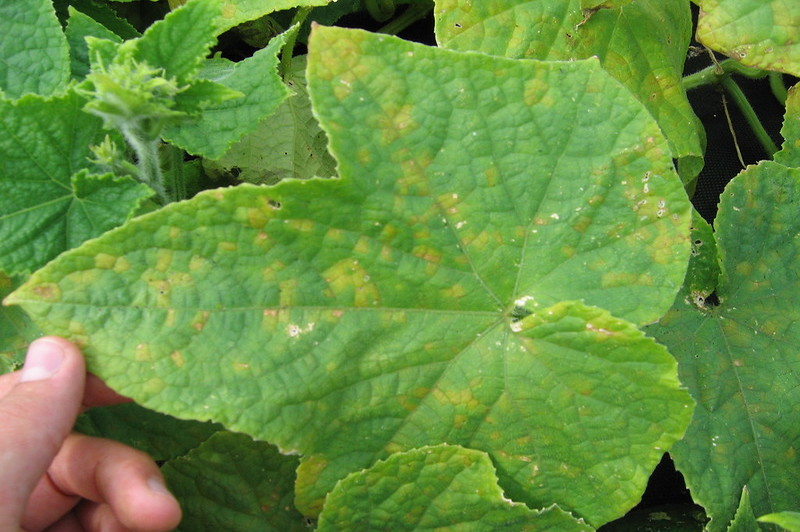If you have a garden, you may wonder what is downy mildew? Well, it’s a fuzzy growth that appears on your vegetable leaves.
This organism is a common pest for cucurbit plants like squash, pumpkin, melon, or cucumber.

You must treat your plants once you spot downy mildew. It quickly spreads, and your leaves will die.
This article will help you identify and treat this garden pest. Now your vegetable garden will be in good condition!
What Does Downy Mildew Look Like?
Downy mildew resembles algae more than a fungus. The blemish comes from the oomycete Pseudoperonospora cubensis.
This pest grows best in wet or humid conditions, and it starts at the leaf. The top part of your infected leaf will have yellowish patches, while the underside will have a grayish and fuzzy layer that resembles soft feathers.
Hence the organism has the name “downy mildew.” This pest can infect vegetable leaves and flowering plants like roses and violets.
Leafy herbs like basil and mint can also develop this mildew. Once the surroundings in your garden meet the right conditions, expect an infestation.
Downy Vs. Powdery Mildew
You may know powdery mildew; it’s a fungus that also grows on outdoor plants. People usually confuse these organisms.
However, it’s essential to know that they’re different, and you must understand their characteristics.
Powdery mildew
This pest is a true pathogenic fungus. Powdery mildew appears as white spots on your plant leaves.
Here’s an article you should read to know what does powdery mildew look like. This fungus will consume all the nutrients on your plant, and eventually cause death.
Humans may also develop some respiratory issues if they inhale powdery mildew spores.
Downy mildew
Downy mildew usually catches homeowners off-guard, because the early signs look like plant nutrient deficiency. It’s only later on when the white and yellow patches appear.
This pest isn’t as dangerous as powdery mold. You can quickly stop the infestation by cutting off the affected leaves.
Downy mildew also isn’t harmful to humans. It will just put your plants in horrible shape.
Why Does This Organism Grow?
Your garden must have the right factors for this organism to grow. Downy mold reproduces through spores, and if they settle in humid conditions they’ll start growing.
Infestations usually happen during hot weather, so be vigilant once Spring and Summer start.
Downy mildew spores can travel through the air, water, and even your hands. You must treat the infestation once you spot it.
Downy Mildew Symptoms In Plants
You should learn how to spot infestation symptoms in your plants. This way, you can control the outbreak before it affects everything.
- Your plant leaves develop yellowish spots, which later become brown.
- Leaf veins bind the spots, usually in an angular way.
- A grayish fuzz develops on the underside of your leaves.
- The leaves are shriveled; like they’ve been exposed to frost
- The leaves start curling upward.
Once you see these signs, you must prune the affected leaves and treat your plants. Here’s a guide on how to get rid of downy mildew.
Is Downy Mildew Dangerous?
You may feel worried when you see downy mildew because it looks similar to powdery mildew. Luckily, this substance isn’t dangerous to humans, and it won’t cause any respiratory issues.
You should be wary of other mildew types that can cause problems when inhaled. Familiarize yourself with how different mildew looks.
This organism will kill your plant leaves if left unattended, which will ultimately kill your plant. Plant damage is the highest risk downy mildew poses.
How To Prevent Downy Mildew
Once you remove the infected leaves, you must ensure the mildew doesn’t come back. Here’s how you can prevent downy mildew:
1. Do regular pruning
Pruning and removing weeds will improve the air circulation around your plant, so the spores can’t settle.
2. Water your plants in the early morning
If you water at this time, the soil will dry better during the day.
3. Choose resistant plant varieties
When you shop for your future plants, try to choose some that are resistant to downy mildew. Your local garden may be able to help you.
Some vegetables have been bred with immunity to this mildew. Try to purchase these plants.
4. Apply a fungicide
These chemicals don’t work on the mildew itself. However, fungicides can protect your plants from mildew before it grows.
Apply the fungicide regularly, especially during the rainy season. A 7 to 10-day interval per application is ideal.
Other Smart Gardening Tips
Ventilation is the most essential thing your plant needs to avoid a mildew infestation. You can help your plant by planting and watering it the right way.
If you put several plants at a time, leave a wide row of space between them. This arrangement will give your plants enough room to breathe and grow well.
Try to apply a drip irrigation system that will control how much water you put in. You can buy home drip irrigation systems in a hardware store.
Your garden will be free from downy mildew and other pests if you follow these steps!
Conclusion
Infestations can cause severe damage to your plants, so you should familiarize yourself with the various pests out there.
You’ll be prepared when you can answer the question “what is downy mildew”. You can do the necessary treatments and preventive measures to keep your garden safe and beautiful.
